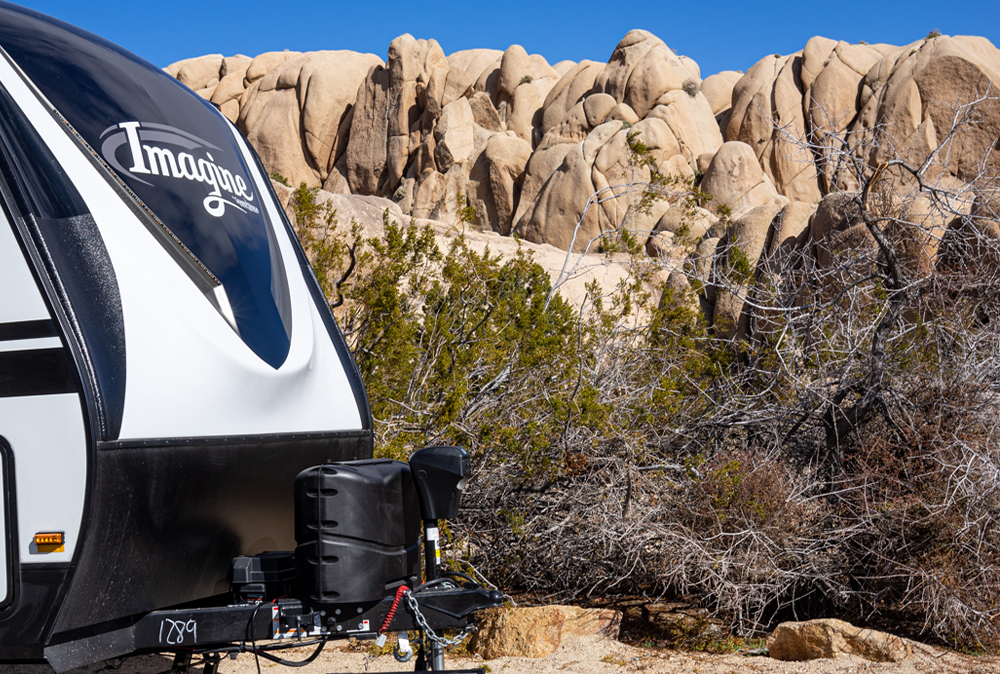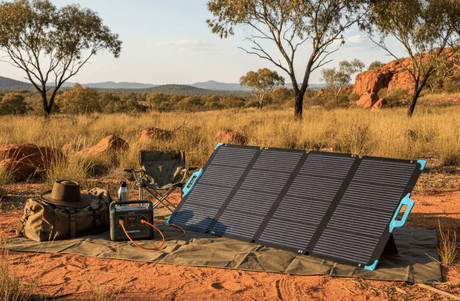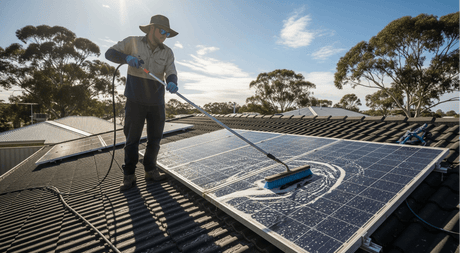If you’re setting up your own solar panels, you need to make sure that you have all of the right components to make it run smoothly. This isn’t as simple as just running down a list of necessary parts. You also need to make sure that the components you choose work together properly, and the inverter is one of the most important parts to get right.
The most simple explanation of an inverter is that it’s the part of your solar power system that converts the DC power generated by solar panels to the AC power that the grid supplies and that your home uses. All of the outlets in your home are AC outlets, so you can’t feed DC power into the system.
AC stands for alternating current. It refers to how the voltage of this current rises and falls in a sine wave around zero, rising and falling between 120 volts and -120 volts. Direct current, on the other hand, runs at a steady voltage. It’s used in most kinds of batteries, from AA batteries to automotive and solar batteries.
In order to make DC power compatible with AC power systems, you’re going to need an inverter. This device takes the DC power source and uses it to generate a source of power like an AC power source. There are two different types of inverters for various applications. Choosing the right type of inverter is critical to successfully generating the source of power you need to run your machine or device.
Choosing the Right Type of Inverter
A modified sine wave inverter generates a modified sine wave. This modified sine wave is actually made up of steps of different voltages rather than a continuous wave. This can get the job done for many applications, but some issues can arise.
The difference between the modified sine wave and a true sine wave is called harmonic distortion, and it can cause issues with lots of different appliances. Anything high-tech will have issues, and many applications like electric motors will run less efficiently.
The solution is to go with pure sine wave inverters. These inverters generate a pure sine wave suitable for any application that regular AC power is. This kind of inverter is needed for grid-tie solar power systems, providing great solar panel rebates. They’re more expensive, but there are many applications where modified sine wave inverters simply won’t do.
Of course, there’s much more variation among inverters than these two main types. One of the most important factors is going to be how much power (measured in watts) the inverter can provide. An inverter with a certain capacity can handle that much wattage, but no more.
It can be difficult to determine what kind of inverter you need for your solar power system or other power sources. Basically, you need to know the maximum power you’ll be using. Beyond that, it’s generally recommended to have around 15% extra just in case.
Finding the right capacity can be as simple as adding up the wattages of the appliances you plan to run at the same time. However, this can be challenging when you consider that high-wattage appliances like microwaves are only used for minutes at a time. Knowing what size inverter is right for what applications can really help.
What Can You Power with a 1000W Inverter?
One thousand watts is a typical inverter size that can provide power for various appliances and electronics.
For instance, 1000 watts happens to be a typical wattage for microwaves. This means that a 1000-watt inverter is perfectly sized to power one microwave oven. This might not sound impressive but consider how quickly a microwave can cook your food.
In fact, 1000 watts is just about the most power use you’re going to find from any individual appliance other than electric heating systems. The challenge here is whether 1000 watts is sufficient to provide power for multiple uses at once. If you have efficient LED bulbs in your home, it’s enough to keep the lights on many times over.
If you’re using a 1000 watt inverter on the go, you’ll likely have more than enough capacity for anything you could possibly need. You could charge nearly 20 cellphones at once or run at least ten laptops. You could even run several large televisions simultaneously.
One thousand watts is great for charging just about anything, making it an excellent addition for long trips. It can be particularly useful for remote worksites where it can provide convenient charging for power tools and some other modern conveniences.
Of course, choosing the right inverter will also come down to what size panels you have. You want to make sure that you have a power inverter capable of handling their entire output or more to account for additional battery storage. You can find out more about the solar panel sizes with our solar panel calculator.
In general, 1000 watt solar inverters are great for off-grid applications like extended camping trips or for anyone who uses solar power for their RV. This kind of power inverter is commonly used even for those who don’t have solar power systems installed because it can be used with a standard 12-volt car battery, making it essentially an all-purpose car adapter.
How Many Batteries Are Needed for a 1000W Inverter?
Battery use is going to depend widely on what exactly you’re running. Battery capacity is measured in amp-hours. Solar batteries could run from 50 amp-hours to 200 amp-hours or higher. A 100 amp-hour battery can supply 100 amps for one hour, one amp for 100 hours, or some combination in between.
For solar power systems, you also need to consider that the panels provide power, so it’s not a simple question of how much power a battery can hold. With battery chargers, you’re restoring your power supply throughout the entire day.
It’s important to consider what type of batteries you’re using here as well. Conventional lead-acid batteries only have a depth discharge of 50% before continued use can cause permanent damage. In effect, your 400 amp-hour battery will only provide 200 amp-hours.
Lithium deep cycle batteries, on the other hand, can be used right down to 0%. That means a 200 amp-hour lithium battery really does deliver 200 amp-hours. You’ll notice that lithium batteries are generally available in sizes that take advantage of this in practice.
For a 1000-watt inverter running at full capacity, you can expect a 200 amp-hour battery to last roughly 2 hours. At half capacity, you could get four hours; quarter capacity could last eight hours, and so on. If you’re not cooking or heating anything, then a 200 amp-hour battery could provide you with enough power to charge devices or use a laptop until the sun comes up to recharge the batteries.
What Can You Power with a 2000W Inverter?
A 2000W inverter can provide you with double the capacity of the 1000W inverter. Most of the portable gas-powered generators you see will deliver power in the range of 2000 watts and 4000 watts, so these kinds of inverters are suitable for just about any sort of task that they are.
One of the key reasons that individuals might choose a 2000W inverter for their DIY solar applications is that it can deliver significant starting watts. Many appliances will have very different wattage requirements to get started compared to continuous running. In many cases, these starting wattage requirements can extend well above 1000 watts, even if they don’t draw anywhere near that continuously running.
A 2000W inverter has enough capacity to power any individual appliance, from microwaves to deep freezers. You might run into trouble running an entire home off of a 2000W inverter, but it’s almost surely more than enough for any of your travel or off-grid applications.
It’s a commonly chosen size because individual appliances are no longer topping out your entire capacity. With a 1000-watt inverter, if you want to run a microwave, that’s the only thing you can do. With a 2000-watt inverter, you can continue charging devices or using a laptop simultaneously, bringing your RV or cottage some real modern convenience.
They’re particularly useful for RVs, where they provide the capacity to run just about everything. They can handle the demand from the appliances in most RVs today, even including air conditioning and heating. If you’re committed to using solar for your RV, 2000 watts is probably the right size inverter for you to enjoy everything you need without any hassle.
In general, 2000 watts is going to be sufficient for just about any solar application you’ll be handling yourself. If you need solar power for your entire home, you could need significantly more, in the range of 6000 to 10000. However, deciding on what equipment you’ll need for a system of that size is best done through professional solar panel installation.
How Many Batteries Are Needed for a 2000W Inverter?
Two thousand watts will be the maximum output from your inverter. However, the way that this corresponds to battery capacity can be very complex. Your 2000-watt inverter can run through a 200 amp-hour battery in an hour when running at full power. However, 2000 watts is a lot of power to maintain for an hour straight.
You’ll need sufficient batteries to maintain your power supply while your solar panels aren’t providing any power. Your panels can only generate so much power over the course of a day before it’s dark, so you’ll likely be left without power at some point in the night. You can charge them during the day and rely on them overnight or even during cloudy days with sufficient batteries.
To find out how many batteries you need, you should consider what your expected power use will be. Are you only going to be using lights and charging devices? Then you probably don’t need an extensive battery bank. If you’re relying on power for heating or AC, then chances are you’ll need more batteries than otherwise.
Batteries can be a significant part of the total cost of your solar power system, so you don’t want to purchase more than necessary. However, you also don’t want to be left with more than you need. In any case, you can always buy more batteries if experience demonstrates that you need them.
The Difference in Cost Between 1000W and 2000W Inverters
Depending on the application you need an inverter for, one of the key determining factors could be the price. There is a wide range of models and brands of inverters, so prices can vary widely. Of course, the larger 2000W inverters will cost more than the 1000W, but many other factors are at play.
In general, you can find 1000W inverters for around $200 or a bit less. This number itself will vary based on the quality, materials of construction, or if you’re looking for a cheaper modified sine wave inverter.
A 1000W pure sine inverter is a cost-effective option for both solar power systems and simply runs appliances off a 12-volt car battery. They’ll generally feature basic safety features like electronic overload protection and an internal DC fuse. You shouldn’t consider cheaper models if they don’t have these features.
You can expect the same key safety features whether you’re in the market for 1000W or 2000W inverters. A 2000W inverter could run as little as $325, with more premium models available. These devices aren’t double the price of 1000W inverters, even though they deliver double the capacity.
Renogy Pure Sine Wave Inverters
Renogy provides a wide range of solar power system components for home and off-grid solar applications. Our selection includes a range of high-quality pure sine wave inverters available from 1000W to 3000W.
No matter your unique requirements or objectives, we have the tech and solar panel components you need to realize your solar ambitions. From solar panel kits to charge controllers and anything in between, Renogy is your source for everything solar.








![What Is a DC to DC Battery Charger [Comprehensive Guide]](http://au.renogy.com/cdn/shop/articles/IMG_3829_bd86de74-31d6-49fd-b9d5-265bb723091d.jpg?v=1757582605&width=460)


